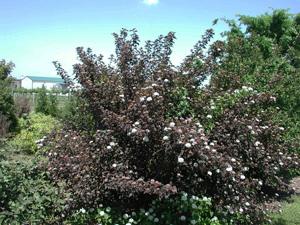Resource Library
Plant of the Week: Ninebark
The University of Arkansas System Division of Agriculture does not promote, support or recommend plants featured in "Plant of the Week." Please consult your local Extension office for plants suitable for your region.
Plant of the Week
Ninebark
Latin: Physocarpus opulifolius

Gardens are a contrived approximation of the natural world. In them we usually find the canopy plantings, the understory and all manner of herbaceous plants all mingled together in an approximation of the natural world – though sometimes it takes a good imagination to see the connections. One of the understory species in the eastern woodlands is ninebark (Physocarpus opulifolius), a plant that has gained renewed interest in gardens because of some unique foliage color forms and good old-fashioned promotion.
Ninebark is a fountain-shaped deciduous shrub with the overall growth form of a large spirea, except with a significantly coarser texture. Like spirea, it belongs to the rose family. Plants can reach 8 feet in height and spread with a distinctive central mass of branches, but given enough time, its arching branches will root at the tip and can form an impenetrable thicket. The coarse textured, alternately arranged deciduous leaves are 2 to 3 inches long with 3 to 5 prominent lobes. In cool areas of the country and when plants are grown in sunny sites, they may take on an orange to red fall color.
The white-to-pinkish clusters of flowers appear in late spring after the leaves have emerged. The clusters of blooms are terminal, to 2 inches across and are comprised of many individual flowers. Following flowering, the inflated, reddish seed pods are produced, which provide an effective display when viewed up close. The Latin name translates as “inflated fruit” and was assigned by Linnaeus according to this characteristic.
The common name “ninebark” is an old one used to describe the exfoliating bark, which was thought to peel off in nine layers. The peeling bark is of interest in the winter but is only prominent on branches as large as your thumb.
About 20 species of ninebark are known in North America and adjacent areas of Northeast Asia, with this species ranging throughout the eastern deciduous lowlands from Oklahoma to eastern Canada. It does not occur in Louisiana, Mississippi or east Texas, showing its aversion for heat and humidity.
The search for new plants led to the introduction of several new ninebark clones since 2000. The first of these, 'Diablo,' is a patented plant discovered at a German nursery in 1968 in a field of 165,000 seedlings. It is the first of the purple- or maroon-leafed ninebarks to hit the market. Now several other copper- or red-leafed selections are also available.
The golden-leafed selection 'Luteus' has been grown since the 1930s and has been updated with newer selections such as 'Dart's Gold' and 'Nugget.' According to A.C. Hottes, who for many years was the garden editor for Better Homes and Gardens, “the fastidious person will probably find the golden-leafed forms unsuitable for the garden.” In the summer heat, the golden forms turn green by midsummer.
Ninebark is an easily grown shrub that has a place in the larger landscape where it can be massed in moist areas adjacent to creeks. The colored foliage forms can be grown in the mixed border strictly for their foliage effect, with plants cut back to the ground every couple years to keep their size in check and prevent them from showing their ungainly nature as they age.
This species is easily grown in full sun or light shade and tolerates a wide array of soil conditions. Once established, it has good drought tolerance. Plants are winter hardy from zone 2 through 8. Overgrown plants can be pruned severely in the spring after flowering to maintain size and form.
By: Gerald Klingaman, retired
Retired Extension Horticulturist - Ornamentals
Extension News - March 11, 2011
The University of Arkansas System Division of Agriculture does not maintain lists of retail outlets where these plants can be purchased. Please check your local nursery or other retail outlets to ask about the availability of these plants for your growing area.